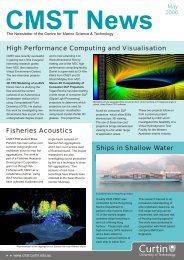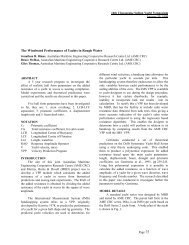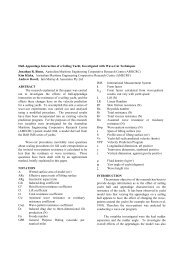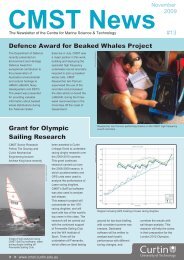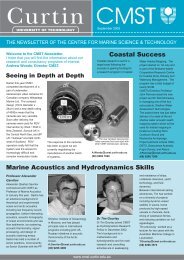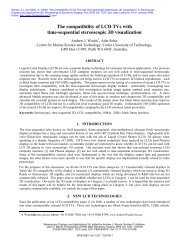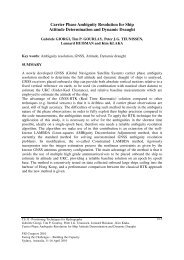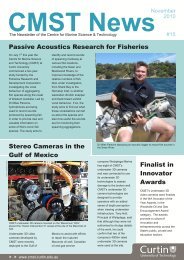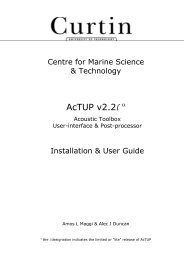investigation of underwater acoustic multi-path doppler and delay ...
investigation of underwater acoustic multi-path doppler and delay ...
investigation of underwater acoustic multi-path doppler and delay ...
You also want an ePaper? Increase the reach of your titles
YUMPU automatically turns print PDFs into web optimized ePapers that Google loves.
INVESTIGATION OF UNDERWATER ACOUSTIC<br />
MULTI-PATH DOPPLER AND DELAY SPREADING<br />
IN A SHALLOW MARINE ENVIRONMENT<br />
Michael Caley <strong>and</strong> Alec Duncan<br />
Curtin University, Department <strong>of</strong> Imaging <strong>and</strong> Applied Physics, Centre for Marine Science <strong>and</strong> Technology, Perth, Australia<br />
michaelcaley@westnet.com.au<br />
Doppler frequency spreading <strong>and</strong> arrival <strong>delay</strong> spreading <strong>of</strong> <strong>underwater</strong> <strong>acoustic</strong> communication signals under the influence<br />
<strong>of</strong> surface waves <strong>and</strong> transmitter-receiver motion were investigated in a channel probing experiment conducted primarily<br />
with binary pseudo-noise (PN) sequences ranging from 21ms to 1.4s duration. Testing was conducted in a 13.5m deep<br />
environment at transmission distances ranging from 44m to 1007m. The channel Doppler response was investigated both<br />
by time-domain Doppler search <strong>of</strong> the transmit-receive correlation for successive repeats <strong>of</strong> a 1.4s probe sequence, <strong>and</strong> by<br />
Fourier analysis <strong>of</strong> the channel impulse response history from a repeated 21ms probe sequence (i.e. Spreading Function).<br />
The bounds <strong>of</strong> Doppler shift imparted by relative transmitter/receiver motion <strong>and</strong> surface wave motion to idealised soundray<br />
transmission <strong>path</strong>s has been compared with experimental Doppler indicated by the Spreading Function. The coherence<br />
<strong>of</strong> the experimental channel response was also examined for different propagation ranges <strong>and</strong> at different <strong>delay</strong>ed arrivals<br />
<strong>of</strong> the experimental signals.<br />
INTRODUCTION<br />
The choice for the wireless transmission <strong>of</strong> data <strong>underwater</strong><br />
is between electromagnetic waves (e.g. light or radio) or sound<br />
waves. Light <strong>and</strong> radio waves are valuable for high-rate data<br />
transmission through water over short ranges <strong>of</strong> the order<br />
<strong>of</strong> a few metres. When transmission is required over longer<br />
distances through water, sound waves are the only viable<br />
wireless option.<br />
Underwater <strong>acoustic</strong> data transmission is not without<br />
signifi cant constraints intrinsic to the marine environment.<br />
The <strong>underwater</strong> <strong>acoustic</strong> environment is highly reverberant,<br />
resulting in <strong>multi</strong>ple refl ected copies <strong>of</strong> any transmitted signal<br />
arriving at the receiver at <strong>delay</strong>ed intervals (<strong>delay</strong> spreading),<br />
<strong>and</strong> with the relative <strong>delay</strong>s generally changing with time. The<br />
frequency <strong>of</strong> transmitted signals is also signifi cantly distorted<br />
by transient Doppler effects generated by elongation <strong>and</strong><br />
contraction <strong>of</strong> surface refl ected transmission <strong>path</strong>s (Doppler<br />
frequency spreading), or Doppler frequency shifts from<br />
movement <strong>of</strong> either (or both) the transmitter <strong>and</strong> receiver.<br />
Transient <strong>delay</strong> spreading <strong>and</strong> Doppler spreading <strong>of</strong> the<br />
received signal present signifi cant challenges to the decoding<br />
<strong>of</strong> incoming data symbols by a communications receiver,<br />
with the problem becoming more diffi cult as the rate <strong>of</strong> data<br />
transmission increases.<br />
In 2011 the Department <strong>of</strong> Electrical <strong>and</strong> Computer<br />
Engineering <strong>and</strong> the Centre for Marine Science <strong>and</strong> Technology<br />
(CMST) at Curtin University commenced a project to develop<br />
high-rate <strong>underwater</strong> <strong>acoustic</strong> communications to support<br />
developing ocean-based industries in Australia [1]. The authors’<br />
role is to develop an <strong>underwater</strong> <strong>acoustic</strong> communication<br />
channel simulator to support this project. The purpose <strong>of</strong> the<br />
simulator is to simulate the way that the real ocean produces<br />
transient distortion <strong>of</strong> <strong>acoustic</strong> communication signals between<br />
a transmitter <strong>and</strong> a receiver, including interference effects from<br />
highly variable natural <strong>and</strong> anthropogenic noise. The simulator<br />
provides a confi gurable analogue <strong>of</strong> the real ocean that can be<br />
used to improve underst<strong>and</strong>ing <strong>of</strong> the infl uence <strong>of</strong> the marine<br />
<strong>acoustic</strong> environment on communications signals, <strong>and</strong> assists<br />
the development <strong>of</strong> <strong>underwater</strong> communication modulation<br />
<strong>and</strong> demodulation algorithms <strong>and</strong> hardware.<br />
Transient phenomena that are key to the development <strong>of</strong> an<br />
<strong>acoustic</strong> channel simulator for high-rate data communications<br />
are the transient <strong>delay</strong> <strong>and</strong> Doppler frequency spreading <strong>of</strong> the<br />
received signal imparted by the moving sea-surface, shown<br />
schematically in Fig. 1, <strong>and</strong> the transient Doppler imparted by<br />
moving transmitter <strong>and</strong>/or receiver platforms [2,3].<br />
Figure 1. Conceptual signal Doppler shift <strong>and</strong> <strong>path</strong> <strong>delay</strong><br />
Experimental channel probing was conducted primarily<br />
with binary pseudo-noise (PN) sequences ranging from 21ms<br />
to 1.4s duration. The signal was created by phase-modulating<br />
a continuous 12kHz sinusoid with the binary sequence. This<br />
method is described in communication literature as Direct<br />
Sequence Spread Spectrum (DSSS) signalling.<br />
In this <strong>investigation</strong> the channel Doppler response to probe<br />
20 - Vol. 41, No. 1, April 2013 Acoustics Australia
signals was investigated both by a time-domain resampling<br />
Doppler search method on successive transmit-receive (txrx)<br />
PN sequence blocks, <strong>and</strong> also by Fourier analysis <strong>of</strong> the channel<br />
response with respect to time, to generate the frequencydomain<br />
Doppler Spreading Function.<br />
It is customary to present the channel Doppler axis <strong>of</strong><br />
the Spreading Function S(τ,f) in the units <strong>of</strong> Hz. S(τ,f) was<br />
calculated in Eq. (1) by discrete Fourier analysis <strong>of</strong> the channel<br />
response h(τ,t).<br />
n=0 i2πnp<br />
S (τ,f) = ∑ h(m,n)exp (- )<br />
(1)<br />
n=N-1 N<br />
S(τ,f) was calculated from N = 1400 impulse responses h(τ,t)<br />
spaced in the time (t) dimension at intervals T = 21ms, with<br />
time t = nT. The impulse response in the <strong>delay</strong> dimension (τ)<br />
was calculated from sampling at frequency fs = 96kHz, with<br />
response <strong>delay</strong> τ = m/fs <strong>and</strong> Doppler frequencies f = p/NT<br />
where p ϵ [-N/2+1,...,N/2].<br />
When the complex channel response h(τ,t) is determined by<br />
cross-correlation <strong>of</strong> a modulated transmit <strong>and</strong> receive signal,<br />
the rate at which the phase <strong>of</strong> h(τ,t) changes with respect to<br />
time (t) is scaled by the probe signal carrier frequency (f0 ).<br />
Accordingly the Doppler shift spectrum at each <strong>delay</strong> (τ)<br />
calculated by DFT <strong>of</strong> h(τ,t) is also scaled by the probe signal<br />
carrier frequency.<br />
For a physical layer modeller it is helpful to note that the<br />
Doppler shift derived by (1) is responsive to h(τ,t) phase changes<br />
originating not only from Doppler phase compression/dilation,<br />
but also from what will be described as ‘apparent’ Doppler due<br />
to phase changes associated with transient phase interference<br />
<strong>of</strong> clustered <strong>multi</strong><strong>path</strong> arrivals, <strong>and</strong> transient angular scattering<br />
<strong>of</strong> propagation <strong>path</strong>s by a moving sea surface [4].<br />
The channel Doppler response may be expressed either<br />
as an equivalent velocity shift δv or as an equivalent signaldependent<br />
frequency shift δf as linked by Eq. (2), where positive<br />
δv represents an equivalent velocity shift that contracts the<br />
propagation <strong>path</strong> length <strong>and</strong> c is the speed <strong>of</strong> sound in water.<br />
δf(f 0 ) = δv/c (2)<br />
In this paper the measured channel Doppler response has<br />
generally been reported as a frequency shift (Hz), but in the<br />
case <strong>of</strong> Spreading Function plots a secondary axis with Doppler<br />
velocity shift was added to enable comparison with Doppler<br />
velocity shift estimates from geometrical considerations.<br />
CHANNEL PROBING TESTS<br />
A shallow (13.5m) channel probing experiment was<br />
conducted in April 2012 over distances ranging from 44m<br />
to 1007m. The transmitter <strong>and</strong> receiver arrangements are<br />
illustrated in Figs. 2 <strong>and</strong> 3, respectively. The transmitter was<br />
inverted (relative to conventional vertical downwards primary<br />
axis alignment) to maximise the signal strength for surface<br />
refl ected transmission <strong>path</strong>s.<br />
Figure 2. Transmitter configuration<br />
Figure 3. Receiver configuration<br />
Experimental arrangement <strong>and</strong> instrumentation<br />
Transmitted <strong>and</strong> received signals were sampled with 24 bit<br />
resolution at 96kHz. Directional surface wave data was<br />
obtained from a Directional Wave Rider Buoy (DWRB)<br />
located approximately 1.5km NE <strong>of</strong> the receiver. The soundspeed<br />
pr<strong>of</strong>i le at each site was sampled with a Conductivity<br />
Temperature Depth (CTD) probe. The vessel was fi tted with<br />
pitch, heave <strong>and</strong> roll data acquisition sampling at 100Hz. Five<br />
temperature loggers sampling at 60 second intervals were<br />
suspended from the surface fl oat line. Grab samples were<br />
collected <strong>of</strong> the s<strong>and</strong>y bottom material.<br />
Probe signals<br />
Probe signals for simultaneous Doppler shift <strong>and</strong> <strong>delay</strong><br />
detection consisted <strong>of</strong> a 12kHz continuous wave (CW)<br />
carrier modulated at a 3kHz chipping rate by binary phase<br />
pseudor<strong>and</strong>om (PN) sequences. The longer temporal effects<br />
Acoustics Australia Vol. 41, No. 1, April 2013 21
associated with wave <strong>and</strong> swell were explored by continuing<br />
the sequence repetitions over an interval greater than the swell<br />
period. A repeated pattern was transmitted consisting <strong>of</strong> 60s <strong>of</strong><br />
1.4s PN sequence (n-bits = 4095), 30s <strong>of</strong> 170ms PN sequence<br />
(n-bits = 511) <strong>and</strong> 30s <strong>of</strong> 21ms PN sequence (n-bits = 63).<br />
This was followed by 30 repeats <strong>of</strong> a 16ms 8kHz-16kHz linear<br />
frequency sweep at 1s intervals. The sweeps were utilised to<br />
provide an unambiguous check on the channel <strong>delay</strong> spread<br />
<strong>and</strong> structure.<br />
The b<strong>and</strong>widths <strong>of</strong> trial signals were guided by the ±3dB<br />
transmit sensitivity <strong>of</strong> the Chelsea Technologies CTG052<br />
transmit transducer. Signals were written to a 24 bit wav fi le<br />
then replayed on a digital audio player with output amplifi cation<br />
to the transmitter.<br />
Doppler <strong>and</strong> <strong>delay</strong> resolution – single block processing<br />
The <strong>delay</strong> resolution δt <strong>of</strong> <strong>multi</strong>-<strong>path</strong> arrivals for a PN probe<br />
signal is determined by the sequence chipping interval tchip as<br />
per Eq. (3). For a linear frequency sweep, δt is the inverse <strong>of</strong><br />
the maximum sweep frequency.<br />
tchip δt =<br />
2<br />
(3)<br />
The Doppler velocity shift resolution δv for a PN sequence<br />
probe signal depends on the sequence repeat interval T <strong>and</strong> the<br />
signal carrier frequency f0 as per Eq. (4) where c is the speed<br />
<strong>of</strong> sound. For a linear frequency sweep, f0 is replaced by the<br />
maximum sweep frequency.<br />
c<br />
δv =<br />
f0T (4)<br />
The probe signal frequencies, repeat intervals, b<strong>and</strong>widths<br />
<strong>and</strong> associated <strong>delay</strong> <strong>and</strong> Doppler resolutions are detailed in<br />
Table 1.<br />
Signal<br />
type<br />
f 0<br />
(kHz)<br />
Table 1. Trial test signals<br />
Period<br />
T (s)<br />
Chipping<br />
rate<br />
δ t<br />
(ms)<br />
δ v<br />
(m/s)<br />
PN 12 1.4 3 0.16 0.094<br />
PN 12 0.17 3 0.16 0.75<br />
PN 12 0.021 3 0.16 6.1<br />
Sweep 8-16 0.016 - 0.06 6.0<br />
Doppler resolution – 21ms ensemble block processing<br />
The Doppler velocity resolution <strong>of</strong> the Spreading Function<br />
from the 21ms probe impulse response history is also calculated<br />
by Eq. (4), but with T evaluated with the block ensemble<br />
duration <strong>of</strong> 30s. The resultant Doppler resolution is 0.0043m/s,<br />
or 0.033Hz, with Nyquist frequency <strong>of</strong> 23.8Hz.<br />
Test sea conditions<br />
The water column was well mixed during testing with<br />
the sound speed ranging almost linearly from 1537m/s at the<br />
surface to 1536m/s at the bottom. Wind conditions were light<br />
to still, with low swell <strong>and</strong> sea conditions reported at 15 minute<br />
intervals from the nearby (1.5km distant) Cottesloe Directional<br />
Wave Rider Buoy (DWRB) as summarised in Table 2. The<br />
appearance <strong>of</strong> the sea surface during testing is illustrated in<br />
Fig. 4. It is notably free <strong>of</strong> surface bubbles.<br />
Wave type<br />
Table 2. Wave height data for presented results<br />
Significant<br />
height H s<br />
Wave period<br />
T m<br />
Wave<br />
frequency<br />
Swell 0.4m 13-14s 0.07Hz<br />
Sea 0.25m 3s 0.33Hz<br />
Figure 4. Experimental sea surface<br />
IDEALISED CHANNEL DELAY STRUCTURE<br />
The arrival <strong>delay</strong> structure for an idealised ocean waveguide<br />
with specular surface <strong>and</strong> bottom refl ections <strong>and</strong> constant<br />
sound speed shown schematically in Fig. 5 is graphed in Fig. 6<br />
to assist with the interpretation <strong>of</strong> the measured <strong>delay</strong> structure.<br />
‘B’ st<strong>and</strong>s for a bottom-bounce, <strong>and</strong> ‘S’ a surface-bounce. It<br />
may be noted that at increasing ranges the time separation<br />
between <strong>delay</strong>s becomes less than the <strong>delay</strong> resolution <strong>of</strong> test<br />
signals listed in Table 1.<br />
Figure 5. Low order reflected <strong>path</strong>s<br />
22 - Vol. 41, No. 1, April 2013 Acoustics Australia
Figure 6. Idealised <strong>delay</strong> structure <strong>of</strong> reflected <strong>path</strong>s relative to the<br />
direct <strong>path</strong><br />
DOPPLER CONTRIBUTIONS FROM<br />
RELATIVE MOTION<br />
The primary geometrical sources <strong>of</strong> relative motion that<br />
contribute to the experimental Doppler shift are sea-surface<br />
motion, wave orbital motion coupling to the suspended<br />
transmitter, <strong>and</strong> transmitter movement generated by vessel<br />
rolling <strong>and</strong> drift as illustrated in Fig. 5. These components were<br />
resolved into the idealised <strong>acoustic</strong> transmission <strong>path</strong>s, then<br />
combined to provide a Doppler velocity shift interpretation<br />
<strong>of</strong> the Doppler effect indicated by the experimental Spreading<br />
Function.<br />
The slow-changing contributions (drift <strong>and</strong> swell orbital<br />
motion) have been treated as constant values, whereas the<br />
rapidly changing stochastic Doppler velocity contributions<br />
from sea-surface refl ections <strong>and</strong> vertical transmitter oscillation<br />
have been quantifi ed as 3σ estimates where σ is the st<strong>and</strong>ard<br />
deviation. Successive surface refl ections <strong>and</strong> vertical<br />
transmitter oscillations have been treated as independent<br />
processes. Only the vertical motion <strong>of</strong> surface refl ections has<br />
been considered. The more complex horizontal surface-wave<br />
velocity components are not considered.<br />
Vessel drift closing speed<br />
The average closing speed Vdrift was calculated from GPS<br />
data for the vessel drift. This speed ranged from 0.11m/s to<br />
0.19m/s for the data presented. This relative motion contributes<br />
almost the same Doppler shift to all transmission <strong>path</strong>s as per<br />
Eq. (5), where θ is the <strong>path</strong> launch angle from horizontal.<br />
V d = V drift cosθ (5)<br />
Transmit-receive motion coupled to orbital wave motion<br />
The cable tether <strong>of</strong> both the transmitter (tx) at 10m depth<br />
<strong>and</strong> the receiver (rx) hydrophone 1m <strong>of</strong>f the bottom make both<br />
susceptible to orbital wave motion, however the movement <strong>of</strong><br />
the receiver hydrophone would be limited compared to that <strong>of</strong><br />
the transmitter. At the depth <strong>of</strong> the transmitter the horizontal<br />
component <strong>of</strong> swell orbital motion is signifi cant in the shallow<br />
test channel, with the contribution from wind-waves not<br />
extending below mid-depth. If it is conservatively assumed that<br />
the transmitter is completely compliant horizontally, the relative<br />
horizontal orbital motion Vorbital is calculated at up to 0.17m/s<br />
for the Table 2 data. This relative motion contributes almost the<br />
same Doppler to all transmission <strong>path</strong>s as per Eq. (6).<br />
Vo = Vorbital cosθ (6)<br />
Surface vertical velocity<br />
The maximum vertical surface velocity Vsurface at the point<br />
<strong>of</strong> surface refl ections was estimated based on the 3σ wave<br />
height for swell <strong>and</strong> sea by Eq. (7), providing estimates <strong>of</strong><br />
0.39m/s for the Hs = 0.25m sea-waves, <strong>and</strong> 0.13m/s for the<br />
Hs = 0.4m swell. The higher estimate obtained from the windwaves<br />
was utilised as an upper bound estimate <strong>of</strong> Vsurface . The<br />
vertical surface motion from a single surface refl ection can be<br />
resolved in the direction <strong>of</strong> an idealised surface-refl ected <strong>path</strong><br />
as per Eq. (8).<br />
Vsurface = 3πHs /2Tm (7)<br />
V s = 2V surface sinθ (8)<br />
Vertical transmitter motion<br />
The vertical velocity spectral density <strong>of</strong> the transmitter in<br />
Fig. 7 was calculated from the combined vessel pitch, heave<br />
<strong>and</strong> roll data by averaging 18 x 160s blocks <strong>of</strong> data with<br />
Hamming windowing. This data shows a peak at 0.07Hz that<br />
corresponds to the DWRB swell data, <strong>and</strong> peaks at frequencies<br />
similar to the DWRB data for wind-driven surface waves.<br />
These higher frequency peaks were likely infl uenced by the<br />
resonant pitch <strong>and</strong> roll frequencies <strong>of</strong> the vessel. The vertical<br />
root-mean-square (RMS) velocity from the data in the 0-2Hz<br />
range was 0.13m/s, providing a 3σ estimate <strong>of</strong> 0.39m/s for this<br />
component.<br />
−50<br />
0 0.5 1<br />
Frequency (Hz)<br />
1.5 2<br />
Figure 7. Transmitter vertical velocity power spectrum<br />
Acoustics Australia Vol. 41, No. 1, April 2013 23<br />
Power spectral density(dB m 2 s −2 /Hz)<br />
0<br />
−10<br />
−20<br />
−30<br />
−40
The vertical transmitter velocity Vtvert can be resolved in<br />
the direction <strong>of</strong> all surface <strong>and</strong>/or bottom refl ected transmission<br />
<strong>path</strong>s as per Eq. (9).<br />
Vt = Vtvert sinθ (9)<br />
Combination <strong>of</strong> geometrical Doppler velocity components<br />
resolved in <strong>path</strong><br />
An estimate <strong>of</strong> the 3σ total in-<strong>path</strong> Doppler shift for a <strong>path</strong><br />
involving nb surface bounces was calculated from components<br />
assuming independence <strong>of</strong> stochastic processes as per Eq. (10).<br />
Vtotal = Vd + Vo + √ Vt 2 + nbV 2<br />
s (10)<br />
Figure 8. 3σ estimates <strong>of</strong> maximum geometrical Doppler velocity<br />
shifts resolved along idealised <strong>path</strong>s for <strong>path</strong> <strong>delay</strong>s < 10ms<br />
The geometrical Doppler components discussed in previous<br />
sections are compared in Fig. 8 for all idealised ray <strong>path</strong>s<br />
within 10ms <strong>delay</strong> relative to the direct <strong>path</strong>, for the example<br />
test distances <strong>of</strong> 110m, 500m, 1007m. The experimental txrx<br />
drift rate varied at each distance. Records <strong>of</strong> wave conditions<br />
from the nearby DWRB were comparable for all transmission<br />
ranges. This analysis indicates that the potential maximum<br />
in-<strong>path</strong> Doppler shift increases signifi cantly with the number<br />
<strong>of</strong> surface bounces at short range, with the vertical surface<br />
Doppler <strong>delay</strong> per surface bounce diminishing with range.<br />
It is noted that the test results relate to relatively low<br />
experimental surface wave heights as per Table 2. Sea <strong>and</strong> swell<br />
are commonly 4-5 times higher at the test site which would<br />
lead to all related Doppler velocity components increasing<br />
commensurately.<br />
EXPERIMENTAL DELAY RESULTS<br />
The transmit-receive correlation versus <strong>delay</strong> histories<br />
are presented for 110m, 500m <strong>and</strong> 1007m transmit ranges in<br />
Figs. 9-11. The correlation response for each time block was<br />
normalised by the product <strong>of</strong> the transmit <strong>and</strong> receive signal<br />
power. The plots are the absolute value <strong>of</strong> the correlation R, so<br />
do not reveal the phase changes occurring in R with time.<br />
Successive block impulse responses were aligned on the<br />
fi rst correlation maxima (with a 0.01ms numerical time step),<br />
without resampling to adjust for cyclical Doppler shift from<br />
txrx movement. Consequently the resultant channel response<br />
history will include distortion <strong>of</strong> the <strong>delay</strong> between the fi rst<br />
maxima <strong>and</strong> subsequent arrivals due to this txrx relative<br />
movement. However the magnitude <strong>of</strong> this <strong>delay</strong> distortion<br />
is less than 0.01ms, less than a tenth <strong>of</strong> the <strong>delay</strong> resolution<br />
for the experimental probe signal. It is concluded that the<br />
‘approximate’ <strong>delay</strong> history obtained in this manner is reliable.<br />
The correlation results from 16ms frequency sweeps at 1s<br />
intervals (not shown) were used to check on the <strong>delay</strong> structure<br />
out to 60ms, confi rming that the 10ms <strong>delay</strong> structure revealed<br />
by the 21ms probe sequence contains the signifi cant arrivals<br />
for this channel.<br />
Utilising the idealised <strong>delay</strong> structure in Fig. 6 for 110m<br />
range for reference, the fi rst correlation maximum in Fig. 9<br />
represents the combined direct <strong>and</strong> bottom-refl ected <strong>path</strong>s,<br />
with the second group <strong>of</strong> arrivals extending between 1ms <strong>and</strong><br />
3ms corresponding to Surface, BS, SB <strong>and</strong> BSB refl ected <strong>path</strong>s.<br />
The next group <strong>of</strong> arrivals for <strong>path</strong>s involving two surface<br />
refl ections are apparent between 6ms <strong>and</strong> 10ms.<br />
At 500m range (Fig. 10) the contracting <strong>of</strong> the <strong>delay</strong> spread<br />
is apparent with two additional b<strong>and</strong>s <strong>of</strong> higher order surface<br />
refl ections evident. The results at this range are notable as the<br />
fi rst correlation maximum is suppressed relative to the second<br />
as a consequence <strong>of</strong> destructive phase interference between the<br />
Direct <strong>and</strong> Bottom <strong>path</strong>s. In this channel the Surface, SB, BS<br />
<strong>and</strong> BSB <strong>path</strong>s combine to provide a stronger arrival, but with<br />
interruption at intervals matching the swell period, presumably<br />
relating to destructive interference associated with differential<br />
<strong>path</strong> elongation/contraction.<br />
At 1007m range the relative phases <strong>of</strong> the Direct, Surface<br />
<strong>and</strong> Bottom bounce again combine constructively to produce a<br />
strongest fi rst correlation maximum.<br />
24 - Vol. 41, No. 1, April 2013 Acoustics Australia
Figure 9. Normalised txrx correlation history (dB)–21ms PN sequence<br />
@ 110m<br />
Figure 10. Normalised txrx correlation history (dB)–21ms PN<br />
sequence @ 500m<br />
Figure 11. Normalised txrx correlation history (dB)–21ms PN<br />
sequence @ 1007m<br />
EXPERIMENTAL DOPPLER SHIFT<br />
RESULTS<br />
Spreading Function Doppler Shift Indication<br />
The Spreading Functions corresponding to the 110m, 500m<br />
<strong>and</strong> 1007m ranges are presented in Figs. 12-14. The Spreading<br />
Functions are over-plotted with white markers representing the<br />
3σ Doppler estimates from geometrical consideration as per Fig.<br />
8, making use <strong>of</strong> the correspondence between Doppler frequency<br />
shift <strong>and</strong> velocity shift in Eq. (2). The corresponding <strong>delay</strong>s <strong>of</strong><br />
the white markers relate to an idealised waveguide with parallel<br />
boundaries. In reality the <strong>delay</strong>s will vary with the <strong>path</strong> elongation<br />
<strong>and</strong> contraction associated with vertical surface movement, <strong>and</strong><br />
with the moving refl ection position linked to travelling surface<br />
waves. The variation in actual <strong>delay</strong> <strong>of</strong> surface-interacting <strong>path</strong>s is<br />
indicated by the substantial <strong>delay</strong>-spreading (x-axis) evident in the<br />
Spreading Function compared to the idealised discrete <strong>delay</strong> points.<br />
Figure 12. Spreading Function (dB) with 3σ geometrical Doppler<br />
estimates @ 110m<br />
Figure 13. Spreading Function (dB) with 3σ geometrical Doppler<br />
estimates @ 500m<br />
Acoustics Australia Vol. 41, No. 1, April 2013 25
The 3σ estimates <strong>of</strong> total Doppler velocity shift from relative<br />
movement on idealised transmission <strong>path</strong>s <strong>and</strong> a simplistic treatment<br />
<strong>of</strong> surface wave movement readily account for Doppler shifted<br />
arrivals within 25dB-30dB <strong>of</strong> the strongest arrival at all <strong>delay</strong>s. This<br />
Doppler estimate from velocity shift is therefore considered useful<br />
to interpretation <strong>of</strong> the Spreading Function Doppler.<br />
Time domain Doppler search method<br />
The results presented below relate to approximately the<br />
same channel as the 110m results in Fig. 9 <strong>and</strong> Fig. 12, but<br />
with transmitter drift extending the average range to 122m, <strong>and</strong><br />
reducing the averaging closing speed from 0.19m/s to 0.13m/s.<br />
Comparison <strong>of</strong> the short PN-sequence channel response history<br />
in Fig. 9 with the long PN-sequence channel response history in<br />
Fig. 15 illustrates how time varying channel Doppler degrades the<br />
txrx correlation for a relatively long 1.4s Doppler-sensitive sequence.<br />
Figure 14. Spreading Function (dB) with 3σ geometrical Doppler<br />
estimates @ 1007m<br />
Figure 15. Normalised txrx correlation (dB)–1.4s PN sequence @ 122m<br />
The correlation versus Doppler <strong>and</strong> time results presented<br />
in Figs. 16, 17 <strong>and</strong> 18 have been generated by block-by-block<br />
Doppler search for <strong>delay</strong> ranges relating to the fi rst, second<br />
<strong>and</strong> third <strong>delay</strong>ed <strong>path</strong> groups illustrated in Fig. 15. Whilst not<br />
shown, the equivalent Doppler frequency range <strong>of</strong> these fi gures<br />
is ± 10 Hz, as for the short-sequence spreading function plots.<br />
The ‘ripples’ either side <strong>of</strong> the correlation maximum in Fig.<br />
16 result from the ambiguity function Doppler side-lobes <strong>of</strong> the<br />
1.4s PN sequence. The cyclical infl uence <strong>of</strong> swell orbital motion<br />
on relative motion is apparent in the Doppler time history for the<br />
fi rst, second <strong>and</strong> third <strong>delay</strong> arrival groups. This time-dependent<br />
Doppler information is not obtainable from the Spreading<br />
Function or the time-domain channel response for the short 21ms<br />
sequence, for which the Doppler resolution <strong>of</strong> 6.1m/s is too coarse<br />
to enable detection <strong>of</strong> Doppler shift from orbital motion.<br />
It appears from the time-domain Doppler analysis that there<br />
are no strong signal arrivals at large Doppler shift, however this<br />
Figure 16. First arrivals normalised correlation (dB) versus time <strong>and</strong><br />
Doppler, 1.4s PN sequence @ 122m<br />
Figure 17. Second arrivals normalised correlation (dB) versus time<br />
<strong>and</strong> Doppler, 1.4s PN sequence @ 122m<br />
26 - Vol. 41, No. 1, April 2013 Acoustics Australia
Figure 18. Third arrivals normalised correlation (dB) versus time <strong>and</strong><br />
Doppler, 1.4s PN sequence @ 122m<br />
does not exclude the possibility <strong>of</strong> such transients occurring at<br />
a signifi cantly shorter time-scale than the 1.4s probe sequence.<br />
However the same time-domain analysis was conducted for<br />
the shorter 170ms PN-sequence channel response (0.75m/s<br />
Doppler resolution) (not presented), which also indicated the<br />
absence <strong>of</strong> isolated strong transients at high Doppler shift.<br />
It is concluded that whilst the Doppler resolution by direct<br />
Doppler search is low, the time history provides valuable<br />
insights into channel behaviour from a channel modelling<br />
perspective.<br />
CHANNEL COHERENCE<br />
The coherence <strong>of</strong> the channel response was explored for<br />
the repeated 21ms probe sequence to investigate the channel<br />
response update rate that would be necessary for a high-fi delity<br />
channel simulator. Results corresponding to the 110m, 500m<br />
<strong>and</strong> 1007m channels are presented in Figs. 19, 20 <strong>and</strong> 21,<br />
respectively. Markers on the fi gures indicate the calculated<br />
coherence at 21ms intervals. The results for each channel<br />
represent the average <strong>of</strong> ten three-second sub-blocks <strong>of</strong> the full<br />
30s sample. The coherence C(t) <strong>of</strong> each sub-block is calculated<br />
for the response within a given <strong>delay</strong> range (τ 1 , τ 2 ) relative to<br />
reference time t 0 by Eq. (10).<br />
C(t) =<br />
τ<br />
∑ 1 h*(τ,t0 )h(τ,t)<br />
τ2 τ<br />
∑ 1<br />
τ<br />
h*(τ,t0 )h(τ,t0 ) ∑ 1 h*(τ,t)h(τ,t)<br />
τ2 τ2 (10)<br />
The results in Figs. 19 to 21 demonstrate high coherence for<br />
the fi rst arrival group at all ranges. Although the strength<br />
<strong>of</strong> subsequent correlation maxima generally degrades with<br />
range, the coherence <strong>of</strong> later arrivals generally improves with<br />
range, consistent with the geometrical trend <strong>of</strong> diminished in<strong>path</strong><br />
Doppler contributions from the moving sea surface as<br />
range increases.<br />
−0.4 −0.2 0<br />
Time, seconds<br />
0.2 0.4<br />
Figure 19. Channel coherence versus time <strong>and</strong> <strong>delay</strong> group @ 110m<br />
Figure 20. Channel coherence versus time <strong>and</strong> <strong>delay</strong> group @ 500m<br />
Figure 21. Channel coherence versus time <strong>and</strong> <strong>delay</strong> group @ 1007m<br />
Acoustics Australia Vol. 41, No. 1, April 2013 27<br />
Coherence<br />
Coherence<br />
Coherence<br />
1<br />
0.9<br />
0.8<br />
0.7<br />
0.6<br />
0.5<br />
1<br />
0.9<br />
0.8<br />
0.7<br />
0.6<br />
0.5<br />
1<br />
0.9<br />
0.8<br />
0.7<br />
0.6<br />
0.5<br />
1st arrival group<br />
2nd arrival group<br />
3rd arrival group<br />
1st arrival group<br />
2nd arrival group<br />
3rd arrival group<br />
4th arrival group<br />
−0.4 −0.2 0<br />
Time, seconds<br />
0.2 0.4<br />
1st arrival group<br />
2nd arrival group<br />
3rd arrival group<br />
4th arrival group<br />
−0.4 −0.2 0<br />
Time, seconds<br />
0.2 0.4
SUMMARY<br />
Time <strong>and</strong> frequency domain analyses <strong>of</strong> experimental<br />
Doppler shift <strong>and</strong> <strong>delay</strong> spreading <strong>of</strong> <strong>underwater</strong> <strong>acoustic</strong><br />
transmissions have been conducted for a shallow marine<br />
environment infl uenced by transmitter drift <strong>and</strong> heave, surface<br />
waves, <strong>and</strong> swell orbital motion. This analysis was conducted<br />
to ascertain channel coherence times <strong>and</strong> the signifi cant sources<br />
<strong>and</strong> scale <strong>of</strong> channel Doppler spreading <strong>and</strong> <strong>delay</strong> spreading<br />
that need to be incorporated into a dynamic channel simulation<br />
for <strong>underwater</strong> communications.<br />
The analysis has shown that the 3σ estimation <strong>of</strong> maximum<br />
channel Doppler shift in the units <strong>of</strong> equivalent velocity from<br />
simplifi ed consideration <strong>of</strong> surface movement <strong>and</strong> relative<br />
motion is a useful approach to explaining the trends in<br />
experimental Doppler indicated by the Spreading Function.<br />
Whilst the Doppler resolution achieved by direct Doppler<br />
search in the time domain is relatively low compared to that<br />
achievable by frequency domain analysis <strong>of</strong> a series <strong>of</strong> probe<br />
responses, it is concluded that the coarse Doppler time history<br />
provided by this approach is complementary to the Spreading<br />
Function in that it clarifi es the origins <strong>of</strong> Doppler shifts<br />
associated with strong channel responses.<br />
Coherence analysis <strong>of</strong> the channel response indicates<br />
that the coherence <strong>of</strong> later arrivals improves with increased<br />
transmission range, consistent with the geometrical trend <strong>of</strong><br />
diminished in-<strong>path</strong> Doppler contributions from the moving sea<br />
surface as range increases.<br />
ACKNOWLEDGMENTS<br />
This project is supported under the Australian Research<br />
Council’s Discovery Projects funding scheme (project number<br />
DP110100736) <strong>and</strong> by L3-Communications Oceania Ltd.<br />
The authors would like to thank Frank Thomas <strong>and</strong> Malcolm<br />
Perry <strong>of</strong> the Centre for Marine Science <strong>and</strong> Technology<br />
(CMST) for technical support, <strong>and</strong> Dr Tim Gourlay <strong>of</strong> CMST<br />
for vessel motion instrumentation <strong>and</strong> data.<br />
REFERENCES<br />
[1] S. Nordholm, Y. Rong, D. Huang, A. Duncan, “Increasing the<br />
range <strong>and</strong> rate <strong>of</strong> <strong>underwater</strong> <strong>acoustic</strong> communication systems<br />
using <strong>multi</strong> hop relay”, Australian Research Council Discovery<br />
Project DP110100736, Curtin University, 2010.<br />
[2] T.H. Eggen, A.B. Baggeroer <strong>and</strong> J.C. Preisig, “Communication over<br />
Doppler spread channels – Part 1: Channel <strong>and</strong> receiver presentation”,<br />
IEEE Journal <strong>of</strong> Oceanic Engineering 25, 62-71 (2000)<br />
[3] P.A. van Walree, T. Jenserud <strong>and</strong> M. Smedsrud, “A discrete-time<br />
channel simulator driven by measured scattering functions”, IEEE<br />
Journal on Selected Areas in Communications 26, 1628-1637 (2008)<br />
[4] P.H. Dahl, “High frequency forward scattering from the sea<br />
surface: The characteristic scales <strong>of</strong> time <strong>and</strong> angle spreading”,<br />
IEEE Journal <strong>of</strong> Oceanic Engineering 26, 141-151 (2001)<br />
[5] P.A. van Walree, T. Jenserud <strong>and</strong> R. Otnes, “Stretchedexponential<br />
Doppler spectra in <strong>underwater</strong> <strong>acoustic</strong><br />
communication channels”, Journal <strong>of</strong> the Acoustical Society <strong>of</strong><br />
America Express Letters 128(5), EL329-EL334 (2010)<br />
Distance Learning for Acoustics<br />
The Pr<strong>of</strong>essional Education in Acoustics program was established some years ago on the request from the industry due to<br />
a lack <strong>of</strong> regularly available appropriate courses in the formal University programs. It is aimed at providing appropriate<br />
modules to meet the needs <strong>of</strong> those embarking on a career in Acoustics <strong>and</strong> has the support <strong>of</strong> the Association <strong>of</strong> Australian<br />
Acoustical Consultants (AAAC). It is also be <strong>of</strong> value for those working in government agencies <strong>and</strong> allied organisations<br />
needing a fundamental underst<strong>and</strong>ing <strong>of</strong> <strong>acoustic</strong>s. The program is based on a similar program that has been <strong>of</strong>fered via<br />
universities <strong>and</strong> the UK Institute <strong>of</strong> Acoustics (IOA).<br />
The program is fully fl exible <strong>and</strong> all undertaken in distance learning mode. This means the modules can be commenced at<br />
any time <strong>and</strong> there is no requirement to complete at a specifi c date. This is an advantage to those who are unsure <strong>of</strong> future<br />
work dem<strong>and</strong>s – but <strong>of</strong> course a disadvantage as the lack <strong>of</strong> a deadline means that completion depends on the commitment<br />
<strong>of</strong> the registrant.<br />
Each module <strong>of</strong> the program will be <strong>of</strong>fered separately in distance learning mode so that it can be undertaken throughout<br />
Australia or elsewhere in the world <strong>and</strong> can be commenced at any time. Each module comprises course notes, assignments<br />
<strong>and</strong> two modules include practical exercises <strong>and</strong> a test. Registrants work through this material at their own pace <strong>and</strong> in their<br />
own location submitting the work electronically. The practical work <strong>and</strong> the test are undertaken at the registrant's location<br />
under supervision <strong>of</strong> their employer. It is expected that those registrants working for <strong>acoustic</strong>al consultancies will receive<br />
support <strong>and</strong> supervision by their supervisors. For registrants who are working on the program without support from their<br />
employer will be given assistance by phone or email from the course coordinator. This assistance can be supplemented with<br />
assistance from a company that is a member <strong>of</strong> the AAAC.<br />
For more information on the program see http://www.aaac.org.au/au/aaac/education.aspx<br />
28 - Vol. 41, No. 1, April 2013 Acoustics Australia



